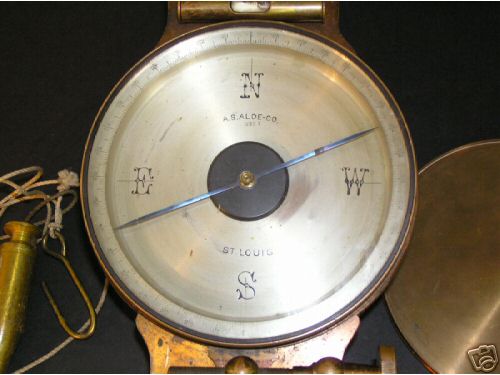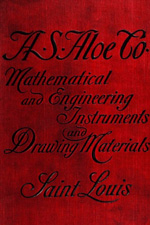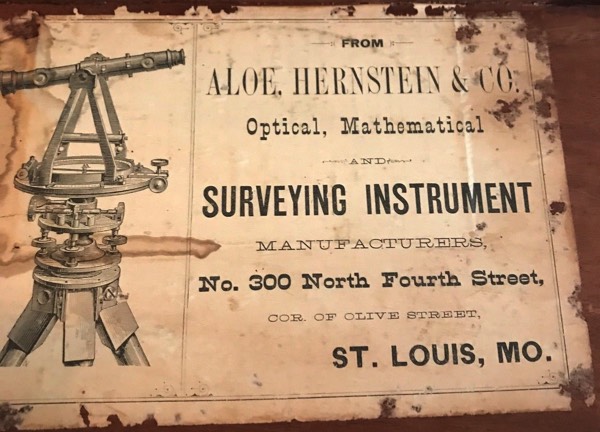
A.S. Aloe & Company
History
A.S. Aloe & Company
(1860-1959, companies)
A.S. Aloe & Company began very modestly as a one-man operation on the corner of Third and Olive in 1860. The company prospered and in 1882 published the following ad: "Largest House in the States....Always on hand a large supply of Engineer and Surveyor’s Transits, Levels, Compasses, Mining Transits and Compasses, Drawing and Profile Paper, etc." The growth did not stop there. A 1905 ad simply stated "...the largest house in the world." Disregarding the advertising exaggeration typical of the period, in the early 1900’s, A.S. Aloe & Company was the largest supplier of surveying, mathematical instruments and allied goods in St. Louis and was probably the largest west of the Mississippi River.
The company founder, Albert Sidney Aloe was born in 1841 in Edinburgh, Scotland, son of Sadoc and Nancy Aloe. Albert immigrated as a child, probably with his parents, to New York City. His father, Sadoc, was in business there beginning in 1854 as an optician. The term optician at that time applied not only to those who sold optical goods, but also to those who made them. The elder Aloe probably did both.
In 1856 the young Albert left New York. He sailed around Cape Horn working as a deck hand. Albert quit the ship at San Francisco where he remained for a year, probably working in the optical trade as a lens grinder. In search of adventure and fortune, Albert made his way to South America. There he was employed as a mechanical engineer in charge of the construction of a sugar mill. By 1860 Albert had amassed, or so it seemed to him, a young fortune. With this as his backing, he returned to the United States settling in St. Louis, Missouri. Across from the Post Office he established a small business dealing in optical goods.
During this time Albert did not neglect his personal life. In 1863 he married Miss Isabella Prince. She came from a notable Belfast family, her grandfather having been a West Indian governor. This union produced four sons: Sidney, Louis, David and Alfred. The oldest three became prominent in St. Louis business circles, and the youngest was a career officer in the U.S. Army.
By 1865 Albert and his father, Sadoc, were in business together as opticians in St. Louis under the name S. Aloe & Son. In addition to selling eyeglasses, they also sold opera and field glasses, telescopes, microscopes and magnifiers.
This arrangement lasted only a couple of years and in 1867 Albert was in business for himself as A.S. Aloe. In 1876 he went into a partnership with William H. Hernstein. From 1876 until 1880 the company was doing business as Aloe & Hernstein. In 1880 it was changed to Aloe, Hernstein & Company. In 1885 Albert again decided to go his own way and established A.S. Aloe & Company. This was the final form of the company name which was to last 76 years and through two following generations of Aloes.
Soon the company had grown to such an extent it was necessary to divide into departments. The surgical department manufactured and sold all the instruments used in surgery. The photo branch manufactured photographers' equipment. The optical department manufactured and sold, at retail only, optical equipment. The exception to this practice would appear to be surveying instruments. It is not known with certainty if A.S. Aloe & Company made any surveying instruments; however, there is ample evidence the company resold the instruments of other makers (a common practice of the period). These instruments were prominently engraved “A.S. Aloe & Company” with the true maker’s name (A. Wissler, for example) hidden on the instrument. The records of the Gurley Company of New York show that on August 20, 1880, Mr. Aloe of Aloe, Hernstein & Company ordered (in person), two 18" or 20" wye levels. Possibly early in the company’s history there was not a St. Louis supplier of quality instruments. Aloe purchased instruments from Gurley for many years. Later on most of the Aloe instruments were made by Adolph Wissler of St. Louis.
Albert S. Aloe personifies the American success story, landing on these shores as an immigrant child and ending his career as a prominent citizen. His fellow St. Louisans said of him that he started in a small way and grew with the city, becoming an affluent and public-spirited citizen, readily contributing his full share toward the advancement of St. Louis. Albert was involved in many clubs, holding offices at various times in the Masonic Order, Order of Odd Fellows, Benevolent and Protective Order of Elks, and Legion of Honor.
Albert Sidney Aloe passed away on Monday, January 30, 1893, at the age of 51 years. His funeral was held the following Wednesday with friends invited to attend. The obituary carried the notice, “New York papers please copy.”
Upon Albert's death the control of A.S. Aloe & Company was given to his second son, Louis P. Aloe. Louis was born July 20, 1867 in St. Louis. He was groomed from the very beginning for his leadership role. His education began with the Stoddard School, was continued at the Wyman Institute of Alton and he attended Washington University in St. Louis. Louis interrupted his education to work in the family business and was listed on the company masthead as secretary/treasurer at the time of his father’s death.
The company was incorporated in 1893, the same year as Albert’s death. With incorporation came a new modern letterhead for each department. These letterheads carried a list of major items sold by that department and an appropriate engraved logo, i.e. a wye level for the mathematical instrument department, a camera on the photographic department stationary and the ubiquitous spectacles for the optical department. A.S. Aloe continued to be carried as president on the letterhead through the year 1895, possibly to reflect a period of mourning. Later the masthead was changed to read, "L.P. Aloe, Prest. & Treas.; D.B. Aloe, Vice-prest.; T.D. Benjamin, Secretary."
Under Louis' leadership the company continued to prosper and grow. It became necessary to separate the optical and surgical departments. The optical department remained at 5th and Olive and the surgical department moved to 1921 Olive. The company suffered a disastrous fire in 1912; however, they soon rebuilt and were doing business as usual.
Louis Aloe not only ran A.S. Aloe & Company with a steady hand, but was active in the business community as well. He was president of the National Association of Surgical Dealers of U.S. and Canada, a member of the executive board of the Business Men's League of the City of St. Louis and president of the Columbian Club,"...one of the largest and most representative social clubs of the city." He was a member of Temple Shaare Emeth and was noted for his untiring work for Jewish organizations.
Besides being an astute business leader, Louis was from an early age involved in politics. He was secretary of the Young Republicans of Missouri, a member at large of the Republican State Committee and for four years he was a Republican member on the Board of Election Commissioners. He also was given the honor of serving as delegate to the National Republican Convention, at which he participated in the naming of both McKinley and Roosevelt as the Republican candidates for president.
Being involved in local politics, he was instrumental in writing the city charter, and in 1915 was elected president of the St. Louis Board of Aldermen. In this capacity he proposed many sweeping changes. He backed a comprehensive city plan to control development and to protect residential areas from the encroachment of industry. To assist the working people he proposed an all night "lawyerless" court. He also advocated strict enforcement of the eight hour work day and payment of union scale wages in all city departments.
St. Louis Mayor Henry Kiel became suddenly ill and Louis assumed the post of Acting Mayor. In this position, Louis focused St. Louis on helping the country win the war. Louis was reelected President of the Board of Aldermen in 1919. In this position, Louis helped muster support for 87 million dollars in bond issues for civic improvement projects. In 1921, the issue was passed, at that time it was the largest bond measure of any American city. In 1925, Louis ran for Mayor of St. Louis. He stood on his record as a member of the Board of Aldermen and as an ordinary businessman, stressing common sense. In heavily Republican 1920’s St. Louis, the only thing between Aloe and the Mayor’s office was the primary election. With the support of several local newspapers and in expectation of support from his alderman work and the Jewish vote, Louis was confident of a win. He was deeply disappointed when he finished second in a three-man race, laying anti-Semitism as a contributing factor to his loss.
Louis and his wife had four children, all girls: Clarable, Viola, Isabel, and Louise. The fate of the company was to revolve around Isabel, who, while attending Smith College, met (on a blind date) Howard F. Baer. Howard was the son of David Baer, a German-Jewish immigrant who had made his money as a whisky wholesaler before prohibition. Howard and Isabel were married in 1926. Howard graduated from Princeton and worked for his uncle in Charleston, West Virginia until Louis' failing health brought Howard and Isabel to St. Louis in 1927.
After only 24 months on the job, Howard found himself as head of A.S. Aloe & Company, with the death of his father-in-law, Louis Aloe. Faced with the responsibility of a large successful company at the onset of the Great Depression, Howard said, "I was scared to death...I worked like hell and cut the budget." And cut the budget he did. By 1930 he had sold all departments except the surgical supply. The medical supply unit went on to become national in scope and eventually merged with the Brunswick Corporation in 1959.
Thus ended the largest and most notable supplier of surveying equipment in St. Louis. A.S. Aloe & Company fell victim of the Great Depression, along with many other corporations large and small.
A.S. Aloe & Company (1860-1959, companies)
A.S. Aloe & Company began very modestly as a one-man operation on the corner of Third and Olive in 1860. The company prospered and in 1882 published the following ad: "Largest House in the States....Always on hand a large supply of Engineer and Surveyor’s Transits, Levels, Compasses, Mining Transits and Compasses, Drawing and Profile Paper, etc." The growth did not stop there. A 1905 ad simply stated "...the largest house in the world." Disregarding the advertising exaggeration typical of the period, in the early 1900’s, A.S. Aloe & Company was the largest supplier of surveying, mathematical instruments and allied goods in St. Louis and was probably the largest west of the Mississippi River.
The company founder, Albert Sidney Aloe was born in 1841 in Edinburgh, Scotland, son of Sadoc and Nancy Aloe. Albert immigrated as a child, probably with his parents, to New York City. His father, Sadoc, was in business there beginning in 1854 as an optician. The term optician at that time applied not only to those who sold optical goods, but also to those who made them. The elder Aloe probably did both.
In 1856 the young Albert left New York. He sailed around Cape Horn working as a deck hand. Albert quit the ship at San Francisco where he remained for a year, probably working in the optical trade as a lens grinder. In search of adventure and fortune, Albert made his way to South America. There he was employed as a mechanical engineer in charge of the construction of a sugar mill. By 1860 Albert had amassed, or so it seemed to him, a young fortune. With this as his backing, he returned to the United States settling in St. Louis, Missouri. Across from the Post Office he established a small business dealing in optical goods.
During this time Albert did not neglect his personal life. In 1863 he married Miss Isabella Prince. She came from a notable Belfast family, her grandfather having been a West Indian governor. This union produced four sons: Sidney, Louis, David and Alfred. The oldest three became prominent in St. Louis business circles, and the youngest was a career officer in the U.S. Army.
By 1865 Albert and his father, Sadoc, were in business together as opticians in St. Louis under the name S. Aloe & Son. In addition to selling eyeglasses, they also sold opera and field glasses, telescopes, microscopes and magnifiers.
This arrangement lasted only a couple of years and in 1867 Albert was in business for himself as A.S. Aloe. In 1876 he went into a partnership with William H. Hernstein. From 1876 until 1880 the company was doing business as Aloe & Hernstein. In 1880 it was changed to Aloe, Hernstein & Company. In 1885 Albert again decided to go his own way and established A.S. Aloe & Company. This was the final form of the company name which was to last 76 years and through two following generations of Aloes.
Soon the company had grown to such an extent it was necessary to divide into departments. The surgical department manufactured and sold all the instruments used in surgery. The photo branch manufactured photographers' equipment. The optical department manufactured and sold, at retail only, optical equipment. The exception to this practice would appear to be surveying instruments. It is not known with certainty if A.S. Aloe & Company made any surveying instruments; however, there is ample evidence the company resold the instruments of other makers (a common practice of the period). These instruments were prominently engraved “A.S. Aloe & Company” with the true maker’s name (A. Wissler, for example) hidden on the instrument. The records of the Gurley Company of New York show that on August 20, 1880, Mr. Aloe of Aloe, Hernstein & Company ordered (in person), two 18" or 20" wye levels. Possibly early in the company’s history there was not a St. Louis supplier of quality instruments. Aloe purchased instruments from Gurley for many years. Later on most of the Aloe instruments were made by Adolph Wissler of St. Louis.
A.S. Aloe
Albert S. Aloe was born in Scotland in 1842 and died in St. Louis, Missouri in 1893. The A. S. Aloe Company was founded around 1860.
Catalogues

Impressive Catalogue by Aloe - with a lot of drafting items and numerous instruments:
Labels


Articles
© 2020 Russ Uzes/Contact Me